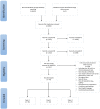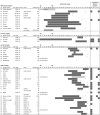A PRISMA systematic review of adolescent gender dysphoria literature: 1) Epidemiology
- PMID: 36962334
- PMCID: PMC10021877
- DOI: 10.1371/journal.pgph.0000245
A PRISMA systematic review of adolescent gender dysphoria literature: 1) Epidemiology
Abstract
It is unclear whether the research literature on adolescent gender dysphoria (GD) provides sufficient evidence to adequately inform clinical decision making. In the first of a series of three papers, this study sought to systematically review published evidence regarding: the prevalence of GD in adolescence; the proportions of natal males/females with GD in adolescence and whether this changed over time; and the pattern of age at (a) onset (b) referral and (c) assessment. Having searched PROSPERO and the Cochrane library for existing systematic reviews (and finding none), we searched Ovid Medline 1946 -October week 4 2020, Embase 1947-present (updated daily), CINAHL 1983-2020, and PsycInfo 1914-2020. The final search was carried out on the 2nd November 2020 using a core strategy including search terms for 'adolescence' and 'gender dysphoria' which was adapted according to the structure of each database. Papers were excluded if they did not clearly report on clinically-verified gender dysphoria, if they were focused on adult populations, if they did not include original data (epidemiological, clinical, or survey) on adolescents (aged at least 12 and under 18 years), or if they were not peer-reviewed journal publications. From 6202 potentially relevant articles (post de-duplication), 38 papers from 11 countries representing between 3000 and 4000 participants were included in our final sample. Most studies were observational cohort studies, usually using retrospective record review (26). A few compared to normative or population datasets; most (31) were published in the past 5 years. There was significant overlap of study samples (accounted for in our quantitative synthesis). No population studies are available, so prevalence is not possible to ascertain. There is evidence of an increase in frequency of presentation to services, and of a shift in the natal sex of referred cases: those assigned female at birth are now in the majority. No data were available on age of onset. Within the included samples the average age was 13 years at referral, 15 years at assessment. All papers were rated by two reviewers using the Crowe Critical Appraisal Tool v1·4 (CCAT). The CCAT quality ratings ranged from 45% to 96%, with a mean of 78%. Almost half the included studies emerged from two treatment centres: there was considerable sample overlap and it is unclear how representative these are of the adolescent GD community more broadly. The increase in clinical presentations of GD, particularly among natal female adolescents, warrants further investigation. Whole population studies using administrative datasets reporting on GD / gender non-conformity may be necessary, along with inter-disciplinary research evaluating the lived experience of adolescents with GD.
Copyright: © 2022 Thompson et al. This is an open access article distributed under the terms of the Creative Commons Attribution License, which permits unrestricted use, distribution, and reproduction in any medium, provided the original author and source are credited.
Conflict of interest statement
The authors have declared that no competing interests exist.
Figures
References
-
- American Psychiatric Association. Diagnostic and statistical manual of mental disorders: DSM-5. 5 ed. Washington, DC.: American Psychiatric Publishing; 2013.
-
- Arnoldussen M, Steensma TD, Popma A, van der Miesen AIR, Twisk JWR, de Vries ALC. Re-evaluation of the Dutch approach: are recently referred transgender youth different compared to earlier referrals? European Child and Adolescent Psychiatry. 2019. doi: 10.1007/s00787-019-01394-6 - DOI - PMC - PubMed
-
- Steensma TD, Cohen-Kettenis PT, Zucker KJ. Evidence for a Change in the Sex Ratio of Children Referred for Gender Dysphoria: Data from the Center of Expertise on Gender Dysphoria in Amsterdam (1988–2016). Journal of Sex & Marital Therapy. 2018;44(7):713–5. doi: 10.1080/0092623X.2018.1437580 - DOI - PubMed
LinkOut - more resources
Full Text Sources
Miscellaneous


